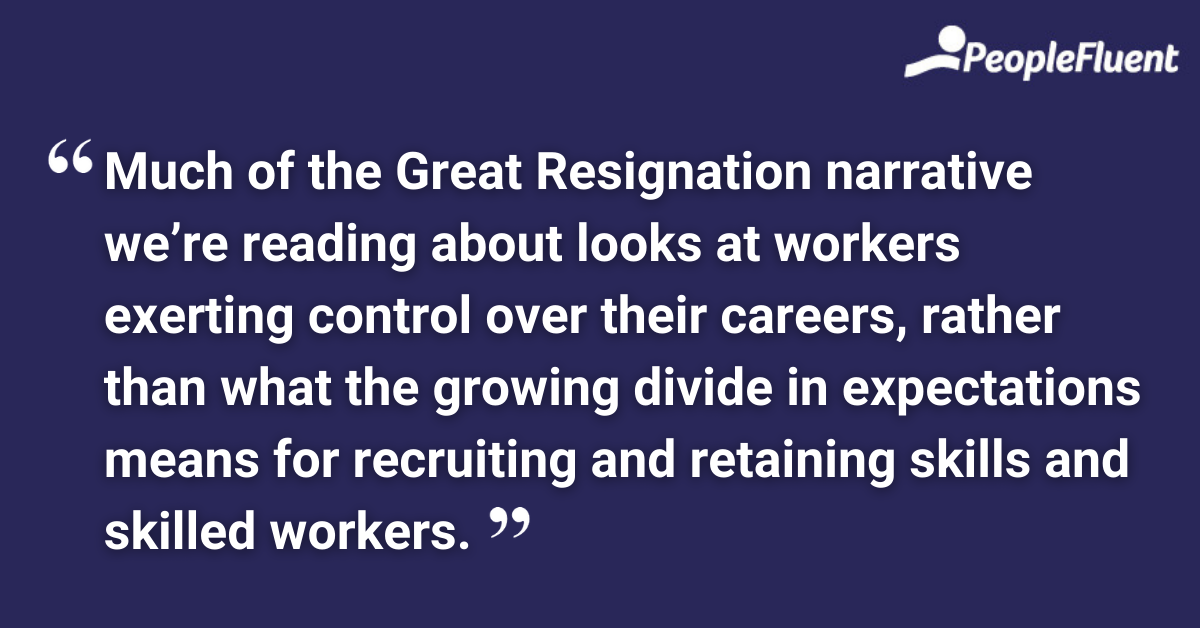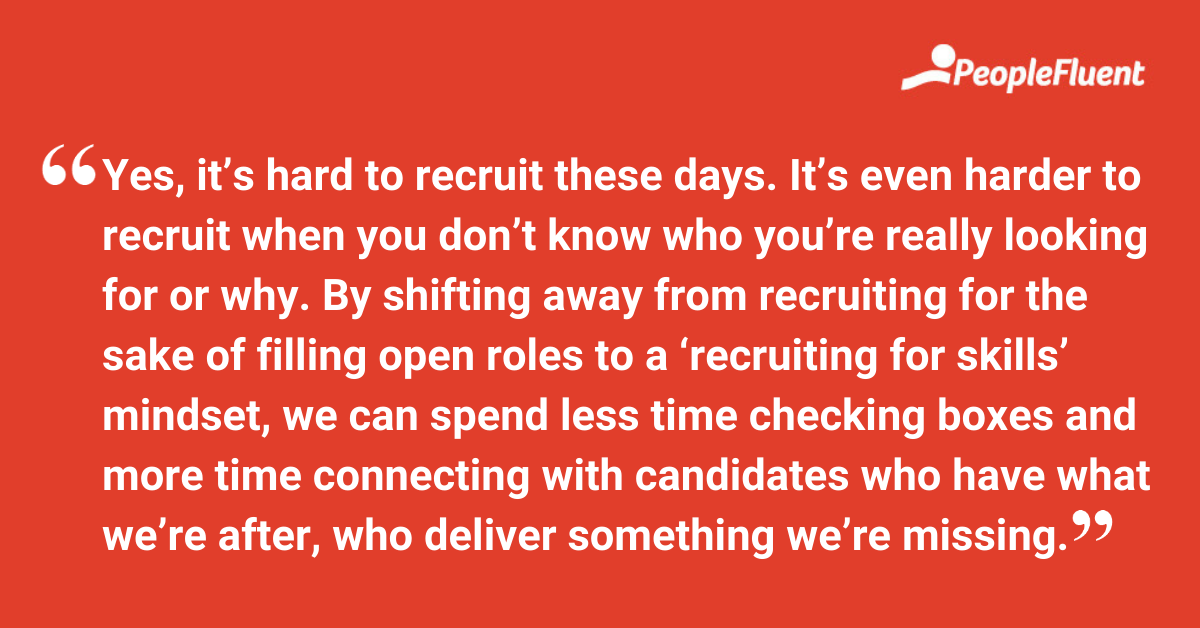Published: Oct 12, 2021Time to read: 7mins Category: Insights
The Rise of Skills in a Revised Talent Landscape
The talent landscape has changed and the skills conversations of 2019 are now a thing of the past. As we move forward, organizations will need to figure out how to identify and nurture skills in the workforce—whether that’s recruiting with skills in mind, or developing talent internally.
Before the pandemic, the topic of skills simmered away in the background. There was ample research from the likes of McKinsey that indicated the value of reskilling and upskilling the workforce in order to prepare for a nebulous “future of work.”At the time (this was back in 2019), McKinsey focused on the influence of artificial intelligence, noting, “Within 60 percent of jobs, at least 30 percent of activities could be automated by adapting currently demonstrated technologies…All workers will need to adapt as machines take over routine and some physical tasks and as demand grows for work involving socio-emotional, creative, technological, and higher cognitive skills.”
McKinsey wrote those words from a place of knowing, having modeled various scenarios across different timelines to understand how AI would disrupt industries. What McKinsey didn’t account for was COVID-19.
Almost no one did...
How the Pandemic Changed Everything
During the outset of the global health crisis, thinking about the future of work ground to a standstill, with most organizations just trying to make it through the day. But given the sustained impact of the pandemic, we see the skills conversation is heating back up.
Today, the concern isn’t so much about machines and automation as it is the changing workforce. Before, employers told workers they needed to change to make themselves viable in the long run. Today, workers are telling employers that it’s the other way around. Until this point, much of the Great Resignation narrative we’re reading about looks at workers exerting control over their careers rather than what the growing divide in expectations means for recruiting and retaining skills and skilled workers.
As industry analyst Josh Bersin succinctly put it, “Who we hire, how we pay, who we promote, and how we organize our companies are all built on the fundamental building blocks of skills. Every time the CEO wants to go in a new direction, skills and capabilities are fundamental to execution… Virtually every decision we make about people is somehow based on skills.”
If we thought skills were essential before COVID-19, Bersin drives home that we didn’t know how important. The changes we’ve witnessed—and continue to witness—reveal that there’s much more to the skills story than we realize.
And it all starts with recruiting!

HANDPICKED FOR YOU | ‘3 Ways to Use Skills-Based Recruiting to Improve Retention’
Recruiting for Skills
Talent acquisition expert Tim Sackett recently mused that the one thing everyone’s talking about is how hard it is to recruit these days. He then goes on to encourage recruiters to draw on the motivational saying “Choose your hard.” Sackett elaborates on this idea, writing: “Working harder is a short-term fix, that eventually leads to failure and burnout. Hard is doing the work that needs to be done, so your sole strategy is not just working harder.”
Yes, it’s hard to recruit these days. It’s even harder to recruit when you don’t know who you’re really looking for or why. By shifting away from recruiting for the sake of filling open roles to a ‘recruiting for skills’ mindset, we can spend less time checking boxes and more time connecting with candidates who have what we’re after, who deliver something we’re missing.
Brandon Hall Group’s 2021 Competency and Skills Development Study identifies the vital skills that today’s companies are after. The majority of those included were soft skills like learning agility and collaboration. To account for skills in recruiting, we need to be able to explain not only what’s required of a given position, but also why. What will your desired skills mean for your organization? Will they create a competitive advantage? What benefit do they add?

Promoting Talent Mobility
To fully grasp what’s needed, first, we need to figure out what—if anything—is missing. According to data analyst company Emsi, “Too often job seekers only see value in their past titles or formal education. In actuality, we accumulate valuable skills in many ways beyond just work and education. Self-study, apprenticeships/internships, workforce training programs, and general life experience all develop more relevant skills.” For employers, having access to skills data can help acknowledge the accumulation of skills, uncover the gaps internally, and lead to a better understanding of the external market.
Since talent mobility often takes many forms, this is where we need to reframe the questions we ask to move from why to how, says Bersin. Instead of wondering why this skill or that skill, think about how you develop your existing talent pool to promote mobility before searching for outside candidates. Bersin writes: “How do you build the governance and leadership focus so you can revisit your strategic skills every few years? How do you define and segment operational skills, strategic skills, and basic skills, so people have a roadmap of where to go? How do you source new skills when the jobs they do are not even clearly defined?”
YOU MIGHT ALSO LIKE | ‘Hiring From Within: How To Create a Culture of Internal Mobility’
Closing the Skills Gaps
Katy Tynan, Principal Analyst at Forrester, continues pulling the ‘why and how’ thread by applying it to middle managers, offering, “The misconception about management is that it’s just about telling people what to do. Great leaders make a compelling case for the ‘why’ and leverage coaching to facilitate the ‘how.’ Taking the position that managers aren’t always naturally good as coaches, Tynan explores how upskilling can work to improve this and take organizations from a top-down approach to leadership to one that empowers employees through ongoing development. In this instance, coaching works as connective tissue to pull together skills.
But creating this linkage is just one example. There are other ways to achieve similar outcomes at all levels of the employee journey. The aforementioned apprenticeship and internship programs can support skills development in early-career entrants. Likewise, Goldman Sachs designed a recruiting model that has candidates apply to a skill rather than a division to encourage employees to navigate different career options within the company. The skills fit under broad umbrellas such as business finance and accounting or risk management with ties back to multiple divisions.
Connecting job seekers with skills during the recruiting process removes barriers to entry and accelerates career development. It also serves as a tactic we can replicate across the employee lifecycle.

MORE ON THIS THEME | ‘The Shift From Degree-Based to Skills-Based Hiring: How L&D Can Help’
Tying It All Together: A Holistic Approach to Talent
As we established at the outset, we’re in a revised talent landscape—the skills conversation from 2019 is over, and we’ve started a new one. Throughout the pandemic experience, we’ve seen tremendous changes take hold of the workforce, and as we chart our next course, it’s clear that skills will help guide the way.
There is no denying that recruiting and retention go hand in hand, and with skills as a unified focal point, we can foster collaboration across recruiting, talent management, learning, compensation, and other critical functions to ensure we’re optimizing our efforts. Bersin reinforces this thinking in his evaluation of what he calls the SkillsTech market, pointing to the value of a single “skills taxonomy,” one that underpins everything from sourcing and assessments to performance management and credentialing.
Ultimately, skills are the expertise needed to do the work. Knowing which skills support your desired outcomes makes it possible to help existing employees on their journey and opens doors for new hires eager to find their footing. The good news is that skills can be learned, strengthened, and repurposed. At a time when it remains challenging to plan anything too far in advance, skills can help each of us—and our organizations—keep moving forward.
RELATED READING TO DOWNLOAD TODAY | ‘How to Create a Strong Recruiting Program (Regardless of Your Organization Size!)’
Discover How Recruitment Lets You Find the Right People—Fast
PeopleFluent helps you fill critical roles with the right people and the right skillsets on a global scale. At the same time, it helps you build your employer brand and sharpen your competitive edge.